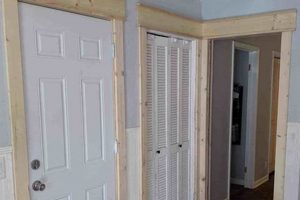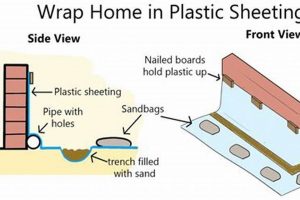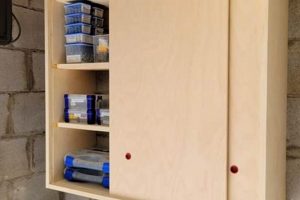The construction of a horizontally moving door system, often inspired by agricultural architecture, undertaken by the homeowner or end-user. An example includes the installation of a track and rollers to facilitate the movement of a wooden panel across a doorway opening.
This approach to door installation presents opportunities for cost reduction compared to professional installation services and allows for customization to match specific aesthetic preferences. Furthermore, this type of door system is advantageous in situations where space is limited, as it eliminates the swing radius of a traditional hinged door. Historically, similar systems were prevalent in agrarian settings, adapted for domestic use for their practicality and visual appeal.
The subsequent discussion will delve into the necessary hardware components, the construction process, and potential challenges encountered when executing such a project. Further considerations will include safety measures, design adaptations, and available resources.
Guidance for Barn-Style Door Implementation
The subsequent points outline critical considerations for successful implementation of a horizontally-sliding door reminiscent of barn structures.
Tip 1: Precise Measurement is Paramount: Accurate dimensions of the doorway opening are crucial before any hardware purchase or panel construction. Failure to obtain precise measurements may result in misalignment or inadequate coverage.
Tip 2: Hardware Selection Based on Panel Weight: The weight of the door panel directly dictates the required load capacity of the track and roller system. Select hardware rated for a weight exceeding the actual panel weight to ensure smooth operation and longevity.
Tip 3: Structural Integrity of Mounting Surface: Ensure the wall where the track is mounted possesses sufficient structural support. Reinforcement may be necessary if the wall is not solid or lacks adequate framing.
Tip 4: Implement a Soft-Close Mechanism: Integrating a soft-close mechanism prevents abrupt stops and reduces noise, extending the lifespan of the system and enhancing user experience.
Tip 5: Maintain Adequate Clearance: Account for sufficient clearance between the door panel and the wall to prevent scraping or binding during operation. Spacers or standoffs may be necessary.
Tip 6: Prioritize Safety Features: Consider incorporating safety latches or anti-jump disks to prevent the door from dislodging from the track.
Tip 7: Level Installation is Essential: Ensure the track is installed perfectly level. An unlevel track will cause the door to slide unintentionally and create operational issues.
Adherence to these recommendations contributes significantly to a functional and aesthetically pleasing outcome, while mitigating potential complications.
The following section will address common pitfalls encountered and strategies for effective troubleshooting.
1. Accurate measurements
In the context of a horizontally moving door installation resembling barn architecture, precise dimensional assessment is paramount. The correlation between dimensional accuracy and project success is direct and undeniable. Erroneous measurements precipitate a cascade of potential complications, rendering the intended functionality of the sliding mechanism compromised. For example, an underestimation of the doorway width necessitates rework of the door panel itself, while an inaccurate height measurement affects the placement of the track, potentially leading to operational difficulties and aesthetic imbalances.
The absence of accurate data negatively influences the entire construction process, from hardware acquisition to the final fitting. Track length, roller placement, and the door panel dimensions are all predicated on the initial measurements. Installing a track that is too short, due to incorrect initial measurements, forces a complete re-evaluation of the design or a costly replacement of materials. Similarly, the door panel cannot effectively cover the opening if its dimensions are miscalculated. The structural integrity of the installation is also impacted; if the spacing between mounting points is calculated based on flawed data, the entire system may lack sufficient stability.
In summary, the reliability of the initial dimensional assessment is crucial for a successful installation. Neglecting this fundamental stage results in unnecessary material waste, increased labor expenditure, and a compromised final product. The implications of inaccurate measurements extend beyond mere aesthetics, directly impacting the operational integrity and longevity of the installed system.
2. Hardware compatibility
Hardware compatibility is an indispensable component of the successful implementation of horizontally sliding door systems reminiscent of barn structures. The selection of appropriate hardware directly influences the operational smoothness, structural integrity, and longevity of the system. Incompatible components can lead to functional deficiencies, safety hazards, and premature system failure. For instance, utilizing rollers with an insufficient load rating for the door panel’s weight will cause undue stress on the system, leading to accelerated wear and potential derailment. Conversely, a track incompatible with the roller assembly will produce friction, hindering smooth operation and potentially damaging both components.
The practical significance of hardware compatibility extends beyond mere functionality. Correctly matched components simplify the installation process, reducing the potential for errors and rework. For example, a track designed for a specific roller assembly will feature precisely aligned mounting points, minimizing the need for custom modifications. Moreover, compatible hardware enhances the aesthetic appeal of the finished product. Harmonious integration of components creates a visually coherent system, reflecting a higher level of craftsmanship and attention to detail. A system that integrates a soft close mechanism is the case, as the soft close mechanism and the barn door sliding kit has to be compatible.
In summation, the relationship between hardware compatibility and successful horizontally sliding door implementation is causal and critical. Prioritizing the selection of appropriately matched components is essential for ensuring optimal performance, safety, and aesthetic value. Neglecting this aspect introduces significant risks, potentially undermining the entire project. A clear understanding of the specifications, load ratings, and material properties of each component is therefore crucial for those undertaking such projects.
3. Structural reinforcement
Structural reinforcement, in the context of horizontally sliding doors reminiscent of barn structures, is a critical factor influencing the system’s stability, longevity, and overall safety. The inherent weight of these door systems, coupled with the dynamic stresses induced by frequent operation, necessitates robust reinforcement to prevent structural failure and ensure reliable performance.
- Wall Framing Integrity
Existing wall framing often requires augmentation to bear the concentrated load imposed by the track and door panel. Insufficient framing can lead to wall deflection, track detachment, and ultimately, system failure. Reinforcement typically involves adding horizontal blocking between studs, increasing the stud density, or integrating a header board to distribute the load across a wider area. Failure to adequately reinforce the framing results in compromised structural integrity and potential safety hazards.
- Header Board Installation
A header board, typically constructed from lumber or engineered wood, serves as a load-bearing element directly supporting the track. The dimensions and material properties of the header board must be carefully selected to accommodate the weight of the door and anticipated dynamic loads. Incorrect sizing or material selection can lead to header board sagging or failure, negatively impacting the door’s operation and potentially causing damage to surrounding structures. Installation techniques, including secure fastening to the wall studs, are paramount to ensuring effective load transfer.
- Track Mounting Hardware
The selection and installation of track mounting hardware directly impact the system’s ability to withstand operational stresses. Lag bolts, through bolts, or specialized mounting brackets are employed to secure the track to the structural framing. The spacing and size of these fasteners must be appropriate for the anticipated loads and the substrate material. Inadequate or improperly installed mounting hardware can lead to track detachment and potential safety hazards.
- Addressing Wall Material Limitations
Certain wall materials, such as drywall or plaster, possess limited load-bearing capacity and require specialized reinforcement strategies. Distributing the load across a wider area using backing plates or mounting strips can mitigate the risk of material failure. Alternatively, anchoring directly to the underlying studs or concrete substrate provides a more secure connection. Neglecting the limitations of the wall material can result in fastener pull-out, track instability, and potential structural damage.
The preceding facets underscore the importance of thorough structural assessment and appropriate reinforcement strategies when implementing horizontally sliding doors. Ignoring these considerations compromises the system’s structural integrity, diminishes its operational lifespan, and poses potential safety risks. Diligent attention to structural reinforcement is, therefore, paramount to achieving a safe, functional, and durable installation.
4. Smooth operation
The attainment of smooth operation is a critical objective in any “diy barn door sliding” project. This outcome is not merely an aesthetic preference but a functional necessity, directly impacting the usability, longevity, and safety of the installation. The connection between smooth operation and the overall success of a horizontally sliding door system is causal: inadequate attention to factors influencing movement quality invariably leads to operational deficiencies. For instance, a door that binds or requires excessive force to operate represents a failure in the design or execution. Such a system is likely to experience accelerated wear and tear, increasing the risk of component failure and posing potential safety hazards to users.
Achieving smooth operation necessitates careful consideration of multiple interconnected elements. These include precise track alignment, appropriate roller selection, adequate clearances, and proper lubrication. Track misalignment, even minor deviations, can introduce friction and binding, impeding smooth movement. Selecting rollers with insufficient load capacity results in premature wear and increased rolling resistance. Inadequate clearances between the door panel and adjacent surfaces create friction points that obstruct smooth operation. The absence of lubrication on moving parts exacerbates these issues, further hindering movement and increasing wear. Real-world examples abound: a homeowner neglecting to properly align the track discovers the door requires significant force to open and close; another homeowner selects undersized rollers, leading to their premature failure and necessitating costly replacements. These instances underscore the practical significance of understanding and addressing the factors influencing movement quality.
In summary, smooth operation is an essential attribute of a well-executed horizontally sliding door system. Attaining this outcome requires meticulous attention to detail throughout the design, construction, and installation phases. Neglecting factors influencing movement quality invariably leads to operational deficiencies, diminishing the system’s usability, longevity, and safety. By prioritizing smooth operation, individuals undertaking such projects can ensure a functional and aesthetically pleasing addition to their homes.
5. Safety mechanisms
The integration of safety mechanisms within horizontally sliding door systems, often styled after barn doors and implemented by homeowners, represents a crucial element in mitigating potential hazards and ensuring user well-being. The correlation between the absence of these mechanisms and the increased risk of accidents is direct and demonstrably causal. For instance, a sliding door lacking an anti-jump device is susceptible to dislodgement from the track, potentially resulting in a heavy panel falling and causing injury. Similarly, the absence of a soft-close mechanism increases the likelihood of pinched fingers or abrupt impacts, particularly for vulnerable users such as children or the elderly. Therefore, the incorporation of these mechanisms is not merely a desirable feature but a fundamental requirement for safe operation.
Several practical examples illustrate the significance of safety mechanisms in such installations. Anti-jump devices, typically consisting of small brackets or clips, prevent the door from lifting off the track due to accidental bumps or uneven surfaces. Floor guides or track systems that secure the bottom edge of the door minimize lateral movement and prevent swinging, reducing the risk of collisions. Soft-close mechanisms, often utilizing pneumatic or hydraulic dampeners, control the door’s closing speed, preventing slamming and associated injuries. Furthermore, the application of safety glass or shatter-resistant materials in the door panel itself reduces the risk of lacerations in the event of breakage. The cost-effectiveness of these preventive measures often outweighs the potential medical expenses and liability associated with accidents.
In conclusion, the strategic implementation of safety mechanisms is paramount to the responsible execution of a horizontally sliding door system. While aesthetic considerations and cost-saving measures may influence design choices, compromising on safety should remain unacceptable. A comprehensive understanding of potential hazards and the appropriate application of preventive measures is essential for creating a functional and safe living environment.
6. Aesthetic considerations
Aesthetic considerations are integral to projects involving horizontally-sliding doors reminiscent of barn structures, undertaken by homeowners. The visual impact of the installed system significantly influences the overall ambiance of the space and necessitates careful planning.
- Material Selection and Finish
The choice of materials, encompassing both the door panel and the hardware, dictates the visual character of the installation. Reclaimed wood imparts a rustic aesthetic, while painted surfaces allow for seamless integration with existing color schemes. Hardware finishes, ranging from matte black to brushed nickel, contribute to the overall style. The materials and finishes should complement the surrounding dcor, ensuring a cohesive design.
- Door Panel Design and Detailing
The configuration of the door panel itself offers numerous opportunities for aesthetic customization. Simple, unadorned panels evoke a minimalist sensibility, while more elaborate designs, featuring decorative inlays or applied moldings, create a more ornate impression. The scale and proportions of the panel should be carefully considered in relation to the doorway opening and the surrounding architectural elements. The symmetry of the panel should also be examined; asymmetry can provide a unique design.
- Hardware Style and Visibility
The visual prominence of the hardware contributes significantly to the aesthetic impact of the installation. Exposed track systems emphasize the industrial character of the sliding mechanism, while concealed systems create a cleaner, more streamlined appearance. The design of the rollers, brackets, and handles should complement the overall aesthetic, avoiding jarring visual incongruities.
- Color Palette and Contrast
The color palette employed in the door system directly influences its visual impact and its relationship to the surrounding space. High-contrast color schemes create a bold statement, while monochromatic palettes foster a sense of harmony and continuity. The color of the door panel should be carefully coordinated with the wall color, the floor covering, and other decorative elements.
These aesthetic considerations are not merely superficial embellishments but rather essential components of a successful project. The thoughtful integration of these elements ensures that the horizontally-sliding door system enhances the visual appeal of the space while fulfilling its functional requirements. The chosen aesthetic needs to resonate with the occupant’s personal taste and fit within the design scheme of the house.
7. Installation precision
The correlation between installation precision and the functional success of a horizontally sliding door system, often self-installed and resembling barn doors, is demonstrably causal and critical. Deviations from precise measurements and alignment introduce operational inefficiencies, reduce the lifespan of components, and potentially compromise user safety. For example, an improperly leveled track will cause the door to drift open or closed unintentionally, necessitating constant adjustments and creating user frustration. Similarly, misaligned mounting hardware places undue stress on the system, leading to accelerated wear and tear on rollers, hinges, or track components. Precise installation, conversely, ensures smooth and reliable operation, extending the system’s longevity and minimizing maintenance requirements. The DIY nature of such projects underscores the importance of this precision, as errors made during installation are often more difficult and costly to rectify than if performed by a professional installer.
Practical applications of this understanding are numerous. Before commencing installation, thorough verification of all measurements is essential. The use of levels, plumb bobs, and laser alignment tools ensures accurate track placement. Securing hardware according to manufacturer specifications, including proper torque settings for fasteners, prevents loosening and misalignment over time. Regular inspection of the installed system allows for early detection and correction of minor deviations before they escalate into more significant problems. For instance, a homeowner noticing a slight bind in the door’s movement can promptly adjust the track alignment, preventing further damage and ensuring continued smooth operation. Ignoring these factors results in diminished functionality, increased maintenance costs, and potentially hazardous operating conditions.
In summary, installation precision is a non-negotiable element in the successful execution of a do-it-yourself horizontally sliding door project. The challenges associated with achieving this precision underscore the need for meticulous planning, careful execution, and ongoing monitoring. By prioritizing accuracy and attention to detail throughout the installation process, homeowners can ensure the long-term performance, safety, and aesthetic appeal of their barn-style door system. The principles of precise installation extend beyond this specific application, emphasizing the importance of accuracy and meticulousness in all DIY projects.
Frequently Asked Questions
The following addresses common inquiries regarding the construction and installation of horizontally-sliding doors, often drawing inspiration from barn structures. The information provided aims to clarify technical aspects and dispel misconceptions.
Question 1: What is the minimum headroom required above a doorway for horizontally-sliding door hardware installation?
Headroom requirements vary depending on the specific hardware kit; however, a minimum of 6 inches is generally recommended to accommodate the track and roller assembly. Consult the manufacturer’s specifications for precise measurements.
Question 2: Is it possible to install a horizontally-sliding door on a drywall partition wall?
Installation on drywall alone is not recommended due to insufficient structural support. Reinforcement with studs or a header board is necessary to ensure the system’s stability and prevent drywall damage.
Question 3: What factors influence the selection of appropriate roller hardware?
Roller selection hinges on the door panel’s weight, thickness, and material. The hardware’s load capacity rating must exceed the door’s weight to ensure smooth operation and prevent premature failure. The track width must be compatible with the rollers.
Question 4: How can noise generated by the sliding mechanism be minimized?
Noise reduction strategies include selecting rollers with nylon or rubberized wheels, lubricating the track regularly, and installing a soft-close mechanism. Ensure the track is properly aligned and free of debris.
Question 5: What safety precautions should be observed during the installation process?
Safety precautions include wearing appropriate personal protective equipment (PPE) such as safety glasses and gloves, utilizing proper lifting techniques to avoid injury, and ensuring the work area is clear of obstructions. Disconnect electrical power if working near wiring.
Question 6: What are the implications of neglecting proper track alignment during installation?
Improper track alignment leads to operational difficulties, including binding, uneven wear, and potential derailment. Precise leveling and alignment are crucial for smooth and reliable door operation. Re-evaluate the level or alignment as needed.
The above answers clarify critical considerations regarding the construction and installation. Neglecting these considerations affects functionality, safety, and long-term performance.
The next section transitions to exploring advanced customization techniques and design adaptations.
DIY Barn Door Sliding
This exposition has delineated the multifaceted aspects of horizontally-sliding door construction, emphasizing structural integrity, hardware compatibility, safety implementation, aesthetic integration, and precision installation. Diligent adherence to established guidelines regarding measurement accuracy and hardware selection is paramount. Furthermore, robust structural reinforcement and the incorporation of appropriate safety mechanisms cannot be understated, as these elements directly influence the system’s reliability and user safety. Aesthetic considerations warrant careful attention to achieve harmonious integration within the intended environment.
Given the complexities inherent in these projects, thorough planning and meticulous execution are imperative for a successful outcome. Individuals embarking on such endeavors should prioritize comprehensive research, rigorous adherence to safety protocols, and a clear understanding of relevant construction principles. The ultimate success hinges upon a commitment to quality and a willingness to address potential challenges proactively. This undertaking is both challenging and rewarding with the right mindset.







